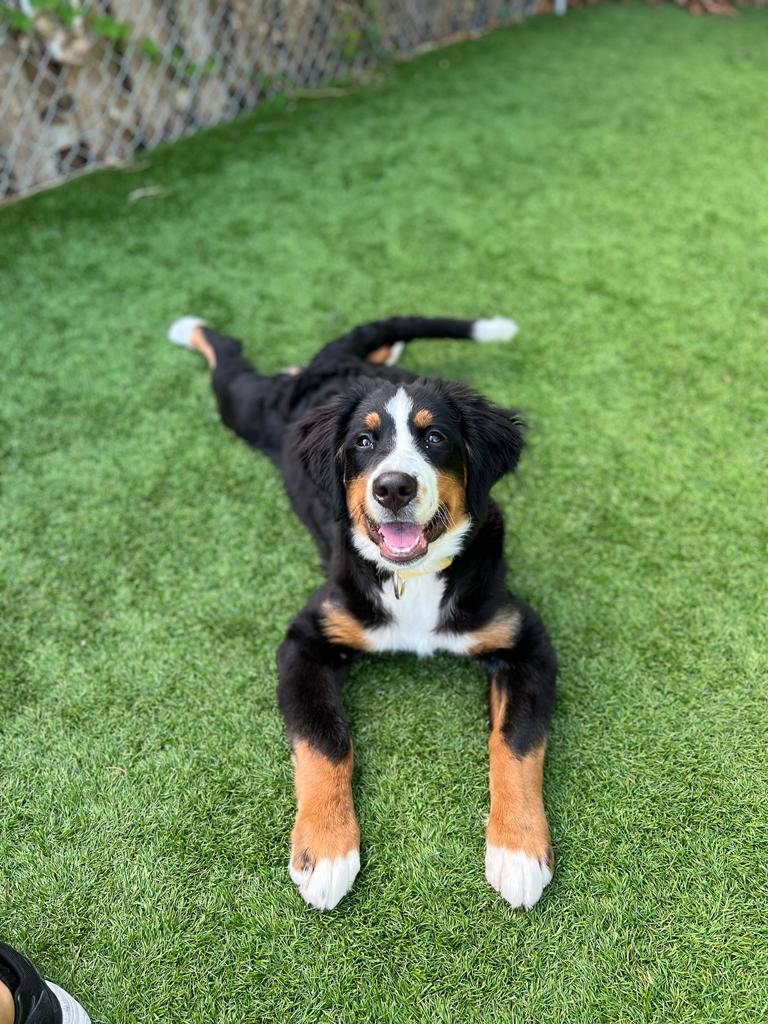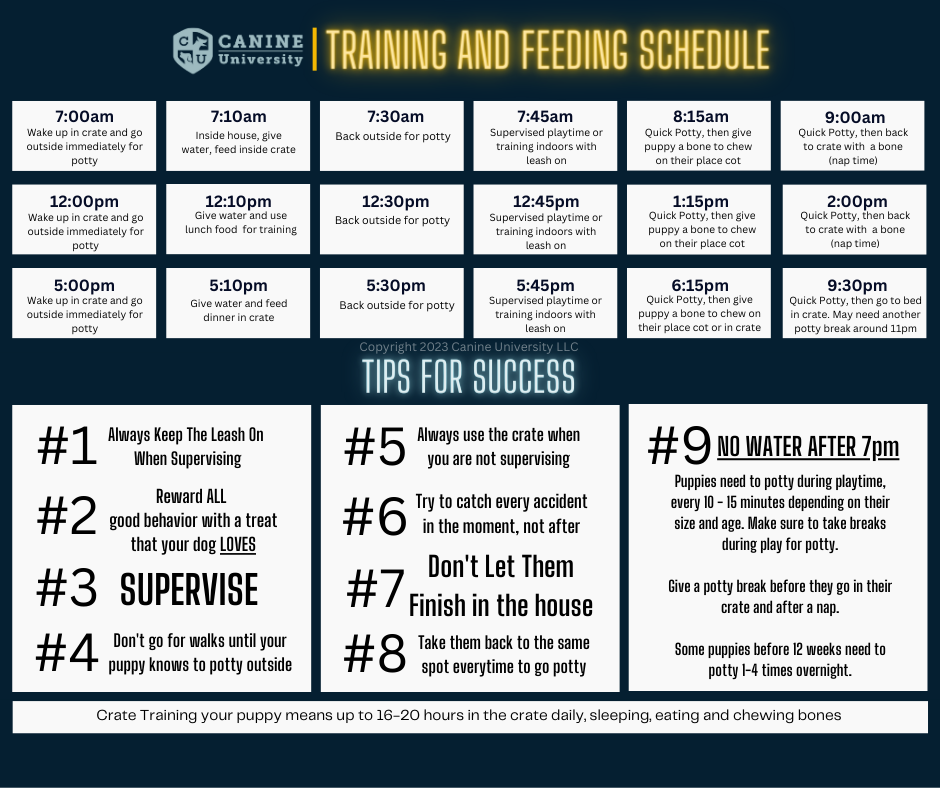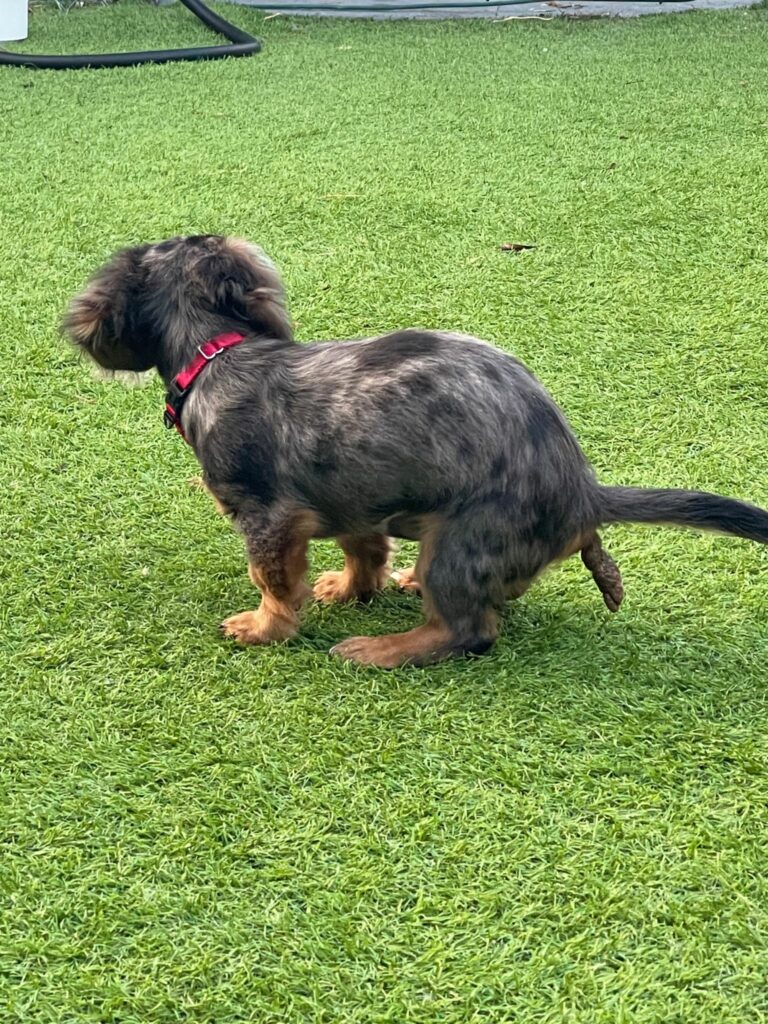
Potty Training/House Breaking Starts at 12 weeks and lasts to 1 Year
The Basics
1. Keep a leash on your puppy when you are supervising them in the house and during playtime. Keeping the leash on will help to desensitize leash and collar and helps you to be prepared to prevent accidents and eliminates you from running at your puppy to pick them up and run them outside (very scary for a puppy). The leash is a great tool to either tether the puppy when you have to step away quickly or to take the puppy with you while you move around the house. Keep in mind you should be taking your puppy outside every 10 - 20 minutes if they are also having free access to water.
2. Take puppy out to eliminate:
3. Take the puppy to the same spot each time to potty. The puppy’s scent will prompt them to go
4. Stay with your puppy outside, at least until fully house trained. Use commands like "Outside!" “Go Pee, Poop!” when you are outside. Use body language to point at where they should go.
5. When your puppy eliminates outside, praise: “Good Pee/Poop!” or give a treat. A walk around the neighborhood is a nice reward, some playtime in the house with you and toys is nice too. Just try not to bring puppy back in and put them in the crate immediately, that wouldn’t be a reward and they may think that there is a connection between elimination and confinement.
6. For Some Puppies, too much praise during elimination is distracting and may stop them from fully peeing because they want to come to you. Try whispering or smiling as praise
7. SUPERVISE, SUPERVISE, SUPERVISE YOUR PUPPY!
8. Limited access to your home and keep them near an exit to the outside potty area.
9. Keep the puppy on a regular feeding schedule (meals at the same time everyday and same portion), and take away leftovers
10. Free access to water and food is not recommended. Small portions of water throughout the day with a potty break afterwards. If you are not home during the day then this can be modified for young puppies.
11. Make your “house training” a training session. Practice playing fetch or teaching tricks in 10 minutes and encourage your puppy to walk to the door to go outside and pee.
NOTE:
If you spend a lot of time with your puppy outside playing, they may be learning to pee and poop whenever they feel the impulse and this may create a setback in your housetraining. Between 8 weeks to 6 months, make sure you are spending time daily playing in the house and encouraging them to “tell you” they have to go out by walking to the door and when they get to the door say “Good Outside! YES!”. You can mark many behaviors in the doorway that help teach your puppy to communicate such as walking to the door, scratching at the door, barking, whining, or ringing a bell. Just remember that that any behavior you reinforce now will become an adult behavior for life- if you don’t want scratch marks on your door, or a barking dog, don’t encourage those behaviors.
Check out our recommended House Breaking Schedule! You can modify the times and your routine as needed for work. In the evenings, most people have more time between 6PM and 10PM. What you do with that time is up to you - just remember the rule is either your puppy is on leash with you everywhere you go or they are in their crate. Don't leave puppies unsupervised or dogs under the age of 1.5 years old.


Here are a few guidelines for using a crate
1. Make sure it is large enough for the puppy to stand, turn around, and lie down, but not big enough for him to use a corner as a bathroom
2. If you are using the crate for more than 4 hours at a time, make sure puppy has fresh water, preferably in a dispenser you can attach to the crate and possibly a crate attached to a playpen where there are pee pads so the puppy pees and poops far from their crate but they are safe in a space with no access to roaming the home freely.
3. If you can’t be home during the house training period, make sure somebody else gives your puppy a break in the middle of the day for the first 8 months
4. If puppy is eliminating in crate, use a playpen attached to crate If they are less than 6 months old and you are gone more than 6 hours. Eliminating in the crate could have several meanings: they may have brought bad habits from the shelter or pet store where they lived before; they may not be getting outside enough; the crate may be too big; or they may be too young to hold it in.
Do's and Don’ts in Potty Training Your Puppy
Keep the following do's and don'ts in mind while housetraining your puppy:
DON’T...
DO...
I hope this article helps get you through the Basics of House Breaking. For more complicated Major house breaking issues. Stay tuned for my book called House Breaking: Fixing Major Canine Potty Training Issues where I address all the scenarios of complicated situations that arise with puppies, rescue dogs and more.